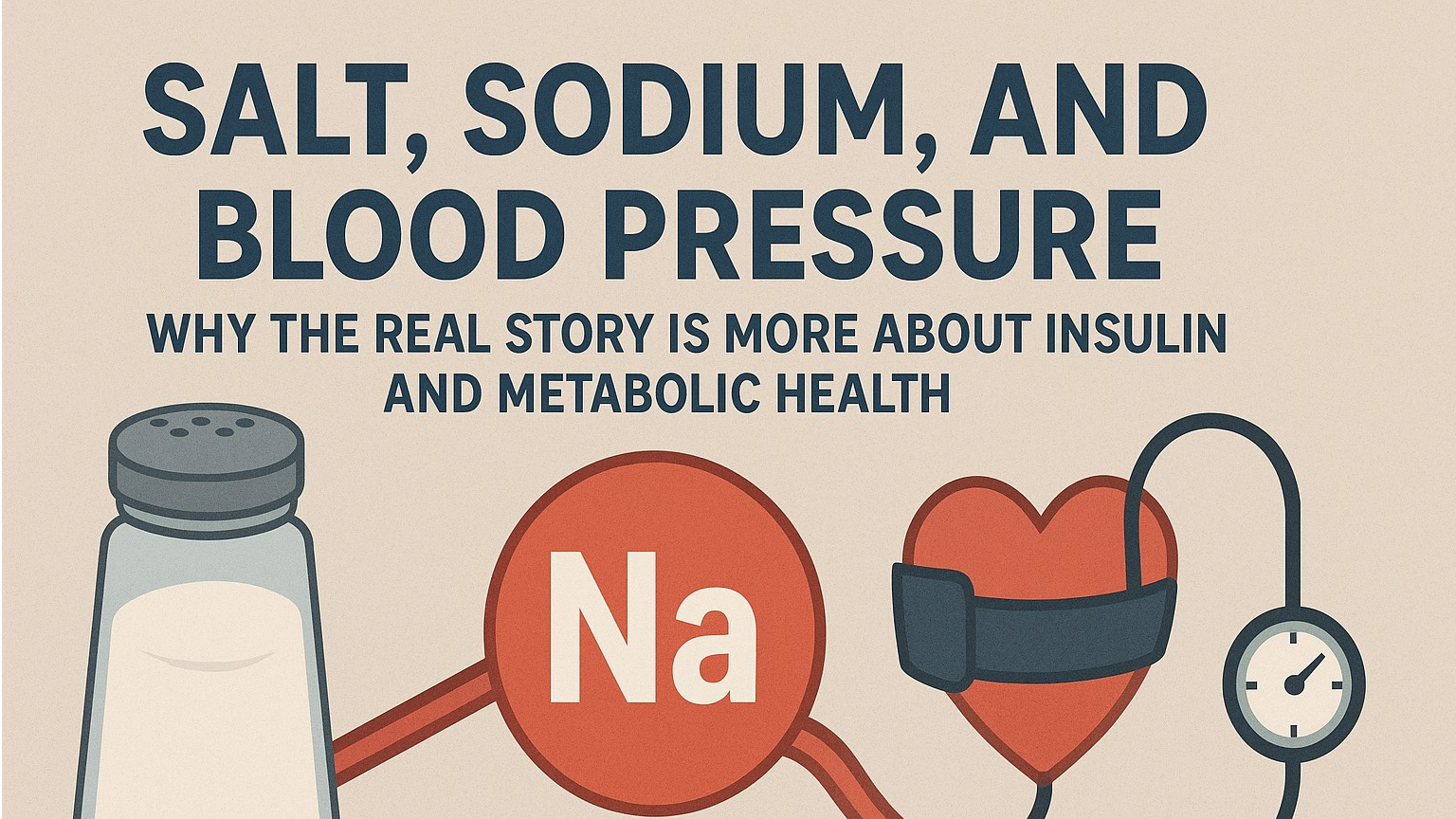
From Villain to Vital Nutrient
For decades, sodium was portrayed as a dietary villain blamed for high blood pressure and heart disease. Public health campaigns urged us to avoid salt. Yet modern science reveals a more nuanced truth. Sodium is essential—vital for fluid balance, muscle contraction, and nerve signaling. Too little is as dangerous as too much. Meanwhile, emerging evidence reveals that the real driver of hypertension isn’t sodium alone—it’s insulin resistance, poor potassium intake, and metabolic dysfunction.
The Origins of the “Salt = Hypertension” Myth
The notion of “salt causes hypertension” traces back to animal studies by Dahl in the 1970s, where high sodium raised blood pressure in salt-sensitive rats. Human data followed, leading to generalized anti-sodium recommendations.
Salt sensitivity actually applies to a subset of people—estimated at 25–50%; many individuals exhibit minimal blood pressure changes regardless of sodium intake (salt-resistant) .
Large observational studies like PURE (Prospective Urban Rural Epidemiology) found a J-shaped curve: very high sodium was harmful, but so was very low sodium intake. Cardiovascular risk was lowest in moderate intake ranges .
Individual variability matters—kidney function, age, insulin resistance, and genetics significantly modify how sodium affects you.
So, the blanket statement “salt causes hypertension” is outdated and overly simplistic.
Insulin Resistance: The Hidden Driver of Sodium Retention
Insulin controls how your kidneys handle sodium. In hyperinsulinemia states, the kidneys retain more sodium, increasing blood volume and pressure .
Additionally, insulin may activate the sympathetic nervous system, tightening blood vessels and further raising blood pressure .
This implies many with hypertension are “insulin-sensitive” rather than “salt-sensitive.” Addressing insulin sensitivity—with diet, movement, sleep, and stress reduction—can impact blood pressure independently of sodium intake.
Sodium + Potassium: The Balancing Act
Potassium counters sodium. It helps the kidneys excrete excess sodium and relaxes blood vessels. Diets low in potassium, which are common in the Western diet, worsen sodium’s effects on blood pressure .
Traditional diets rich in fruits, vegetables, beans, and tubers naturally provide this balance.
The DASH diet (Dietary Approaches to Stop Hypertension) lowers blood pressure in part by emphasizing potassium-rich foods—even without extreme sodium restriction.
How Much Sodium Do We Really Need?
General Guidelines (Non-Training Days)
The AHA recommends up to 2,300 mg/day (≈1 tsp salt), aiming toward 1,500 mg/day for those with hypertension .
The PURE study suggests lowest cardiovascular risk with 3,000–5,000 mg/day, depending on potassium and metabolic health .
Training Days / Athletes
Sweat can lose 500–2,000 mg sodium per liter. Endurance athletes, especially in heat, may need 3,500–5,500 mg/day or more.
Guidance:
<60 min easy training: Water is fine.
60–90 min moderate/hot: ~300–500 mg sodium/hour.
>90 min intense/hot: ~500–1,000 mg sodium/hour.
Signs You’re Getting It Wrong
Too little sodium (relative to need):
Dizziness, headaches, muscle cramps
Brain fog, fatigue, nausea
Frequent urination with very clear urine
In extreme cases: hyponatremia—an emergency
Too much sodium (chronically):
Elevated blood pressure in salt-sensitive individuals
Bloating, swelling (hands, ankles)
Constant thirst
The Type of Salt Matters (But Not As Much As You Think)
Your body cares about sodium, not crystal color—but the form of salt has context:
Iodized table salt: Adds iodine (essential for thyroid health).
Sea salt / Himalayan pink salt: Trace minerals present but negligible nutrition-wise; sodium per gram nearly identical to table salt.
Kosher salt: Larger crystals, great for cooking; often lacks iodine.
Electrolyte salts: Blend sodium with potassium and magnesium—useful for athletes and hot training days.
Specialty salts may taste or look different, but they don’t alter sodium’s effect on blood pressure or physiology.
Smarter Sodium Strategies
Salt whole foods—not processed ones. 70–80% of dietary sodium comes from packaged and restaurant foods, not your shaker.
Boost potassium. Incorporate avocado, beans, leafy greens, yogurt, and squash.
Control insulin. Prioritize exercise, protein-forward whole foods, sleep, and stress management for better sodium handling.
Use the right salt for your iodine needs. If seafood isn’t in your diet, iodized salt is important.
Personalize intake. Monitor blood pressure at home over 2–4 weeks as you adjust sodium and lifestyle.
Sample Day Frameworks
Balanced Rest Day |
Sodium Targets & Strategy ~2,000 mg sodium total |
Breakfast |
Greek yogurt + salted pumpkin seeds (~250 mg) |
Lunch |
Chicken salad with olives, feta, vinaigrette (~600 mg) |
Snack |
Cottage cheese with cucumber (~400 mg) |
Dinner |
Salmon, roasted potatoes, green beans, pinch of sea salt (~750 mg) |
Hot Training Day |
~3,500 mg sodium total |
Pre-Workout |
Water + pinch of salt + half a banana (~200 mg) |
During Training |
Electrolyte drink (~1,000 mg sodium total) |
Post-Workout Meal |
Rice bowl with steak, salsa, avocado (~900 mg) |
Dinner |
Soupy stew with chicken and vegetables (~1,000 mg) |
Snacks |
Pickles/olives if craving salt (~400 mg) |
FAQs
Q: Does salt cause high blood pressure in everyone?
No. Only 25–50% are salt-sensitive; insulin resistance, age, and low potassium often play larger roles .
Q: Should I avoid all processed foods?
Not necessarily—but since most sodium comes from processed sources, cooking at home gives you control.
Q: Is Himalayan salt healthier?
Not for sodium content. Its trace minerals are negligible. If iodized salt isn’t used, ensure iodine from seafood or dairy .
The Takeaway
Sodium is essential, not evil.
Insulin resistance and low potassium drive hypertension more than salt alone.
Most people do well with 2,000–3,500 mg/day, though athletes and hot-weather exercisers may need more.
Personalization beats one-size-fits-all.
-
Prioritize whole foods, metabolic health, and mindful sodium intake.
References
Salt sensitivity estimates and individual variation in blood pressure response
PURE study findings on J-shaped sodium-risk curve
Insulin’s effect on renal sodium retention
Insulin, sympathetic activation, and blood pressure
Potassium’s sodium-excretion effect and guidelines
AHA sodium intake recommendations
NIH iodine guidelines for iodized salt
Sodium sources — processed vs home-cooked (widely reported estimates)
…and based on prior evidence and dietary surveys.
 Add Row
Add Row  Add
Add 










Write A Comment